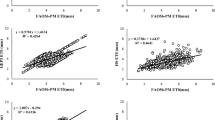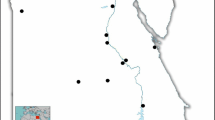Abstract
The radiation-based Priestley–Taylor (PT) model is a common way of modeling evapotranspiration (ET0) when only air temperature and solar radiation records are obtainable. However, this method presents the crucial drawback of requiring an initial local calibration. Most of the existing calibration procedures usually utilize similar patterns (data) for calibrating and testing the ET0 models. In the current research, the PT model and its calibrated versions were evaluated by utilizing meteorological data from 29 weather stations in Iran. Thoroughgoing local and external data scrutinizing procedures (using k-fold validation) were adopted to evaluate the models. Additionally, the externally calibrated models were reevaluated considering vapor pressure deficit (VPD) and net radiation (Rn) records. A similar plan was replicated for assessing the performance of gene expression programming (GEP)–based equations fed with the air temperature and solar radiation data. Both local and external calibrations of the PT model generally improved the accuracy of original PT for estimating ET0, especially in humid and arid stations. External calibration using VPD and Rn data was found to be comparable to locally calibrated and non-calibrated PT models. Local GEP models generally performed more accurately than locally calibrated and non-calibrated PT models. Higher accuracy was also obtained using external GEP models in comparison with non-calibrated PT models.






Similar content being viewed by others
References
Allen RG, Pereira LS, Raes D, Smith M (1998) Crop evapotranspiration. Guide lines for computing crop evapotranspiration. FAO Irrigation and Drainage Paper no. 56, Rome, Italy
Bailey WG, Davies JA (1981) Bulk stomatal resistance contral of evaporation. Bound-Layer Meteorol 20:101–115
Banzhaf W, Nordin P, Keller PE, Francone FD (1998) Genetic programming. Morgan Kaufmann, San Francisco, CA 512 pp
Benli B, Bruggeman A, Oweis T, Ustun H (2010) Performance of Penman-Monteith FAO56 in a semiarid highland environment. J Irrig Drain Eng 136(11):757–765
Berengena J, Gavilàn P (2005) Reference evapotranspiration estimation in a highly advective semiarid environment. J Irrig Drain Eng 131(2):147–163
Burman R, Pochop LO (1994) Evaporation, Evapotranspiration and climatic data. In: Developments in atmospheric science, 22. Elsevier Science B.V., Amsterdam, pp 278
Castellvi F, Stockle CO, Perez PJ, Ibanez M (2001) Comparison of methods for applying the Priestley–Taylor equation at a regional scale. Hydrol Process 15:1609–1620
Cristea NC, Kampf SK, Burges SJ (2013) Revised coefficients for Priestley-Taylor and Makkink-Hansen equations for estimating daily reference evapotranspiration. J Hydrol Eng 18:1289–1300
Davies JA, Allen CD (1973) Equilibrium, potential and actual evaporation from cropped surfaces in southern Ontario. J Appl Meteorol 12:649–657
De Bruin HAR (1978) A simple model for shallow lake evaporation. J Appl Meteorol 17:1132–1134
De Bruin HAR, Holtslag AAM (1982) A simple parameterization of the surface fluxes of sensible and latent heat during daytime compared with the Penman-Monteith concept. J Appl Meteorol 21:1610–1621
Deschaine LM (2014) Decision support for complex planning challenges: combining expert systems, engineering-oriented modeling, machine learning, information theory, and optimization technology. Chalmers University of Technology, Gothenburg ,p 233
Ding R, Kang S, Li F, Zhang Y, Tong L (2013) Evapotranspiration measurement and estimation using modified Priestley–Taylor model in an irrigated maize field with mulching. Agric For Meteorol 168:140–148
Ferreira C (2001a) Gene expression programming: a new adaptive algorithm for solving problems. Comput Syst 13(2):87–129
Ferreira C (2001b) Gene expression programming in problem solving. In: 6th Online World Conference on soft computing in Industrial Applications (invited tutorial)
Ferreira C (2006) Gene expression programming: mathematical modeling by an artificial intelligence. Springer, Berling 478 pp
Gash JHC, Stewart JB (1975) The average surface resistance of a pine forest derived from Bowen ratio measurements. Bound-Layer Meteorol 8:453–464
Goldberg DE (1989) Genetic algorithms in search, optimization, and machine learning. Addison –Wesley, Reading 432 pp
Gunston H, Batchelor CH (1983) A comparison of the Priestley-Taylor and Penman methods for estimating reference crop evapotranspiration in tropical countries. Agric Water Manag 6(1):65–77
Guven A, Kisi O (2010) Daily pan evaporation modeling using linear genetic programming technique. Irrig Sci 29:135–145. https://doi.org/10.1007/s00271-010-0225-5
Guven A, Aytek A, Yuce MI, Aksoy H (2008) Genetic programming-based empirical model for daily reference evapotranspiration estimation. Clean Soil Air Water 36(10–11):905–912
Irmak S, Irmak A, Allen RG, Jones JW (2003) Solar and net radiation-based equations to estimate reference evapotranspiration in humid climates. J Irrig Drain Eng 129(5):336–347
Jensen ME, Burman RD, Allen RG (1990) Evapotranspiration and irrigation water requirements. ASCE Manuals and Reports on Engineering Practice No. 70. American Society of Civil Engineers, New York
Jury WA, Tanner CB (1975) Advection modification of the Priestley-Taylor evapotranspiration formula. Agron J 67:840–842
Kisi O, Guven A (2010) Evapotranspiration modeling using linear genetic programming technique. J Irrig Drain Eng 136(10):715–723
Koza JR (1992) Genetic programming: on the programming of computers by means of natural selection. The MIT Press, Cambridge, p 840
Landeras G, Ortiz-Barredo A, Lopez JJ (2008) Comparison of artificial neural network models and empirical and semi-empirical equations for daily reference evapotranspiration estimation in the Basque Country (Northern Spain). Agric Water Manag 95:553–565
Legates DR, McCabe GJ (1999) Evaluating the use of goodness-of-fit measures in hydrologic and hydroclimatic validation. Water Resour Res 35(1):233–241
Martí P, González-Altozano P, López-Urrea R, Mancha LA, Shiri J (2015) Modeling reference evapotranspiration with calculated targets: assessment and implications. Agric Water Manag 149(2):81–90
McAneney KJ, Itier B (1996) Operational limits to the Priestley-Taylor formula. Irrig Sci 17:37–43
Penman WR (1948) Natural evaporation from open water, bare soil and grass. Proc R Soc Lond A 193(1032):120–145
Pereira AR (2004) The Priestley–Taylor parameter and the decoupling factor for estimating reference evapotranspiration. Agric For Meteorol 125:305–313
Priestley CHB, Taylor RJ (1972) On the assessment of surface heat flux and evaporation using large-scale parameters. Mon Weather Rev 100(2):81–92
Racine J (2000) Consistent cross-validatory model-selection for dependent data: hv-block cross-validation. J Econ 99:39–61
Senatore A, Mendicino G, Cammalleri C, Ciraolo G (2015) Regional-scale modeling of reference evapotranspiration: intercomparison of two simplified temperature- and radiation-based approaches. J Irrig Drain Eng 141:04015022. https://doi.org/10.1061/(ASCE)IR.1943-4774.0000917
Shao J (1993) Linear model selection by cross-validation. J Am Stat Assoc 88(422):486–495
She D, Xia J, Zhang Y (2017) Changes in reference evapotranspiration and its driving factors in the middle reaches of Yellow River Basin, China. Sci Total Environ 607-608:1151–1162
Shiri J, Kisi O, Landeras G, Lopez JJ, Nazemi AH, Stuyt LCPM (2012) Daily reference evapotranspiration modeling by using genetic programming approach in the Basque Country (Northern Spain). J Hydrol 414-415:302–316
Shiri J, Nazemi AH, Sadraddini AA, Landeras G, Kisi O, Marti P (2013) Global cross-station assessment of neuro-fuzzy models for estimating daily reference evapotranspiration. J Hydrol 480:46–57
Shiri J, Nazemi AH, Sadraddini AA, Landeras G, Kisi O, Fakheri Fard A, Marti P (2014a) Comparison of heuristic and empirical approaches for estimating reference evapotranspiration from limited inputs in Iran. Comput Electron Agric 108:230–241
Shiri J, Marti P, Singh VP (2014b) Evaluation of gene expression programming approaches for estimating daily pan evaporation through spatial and temporal data scanning. Hydrol Process 28(3):1215–1225
Shuttleworth WJ (1993) Evaporation. In: Maidment DR (ed) Handbook of hydrology. McGraw-Hill, New York
Sumner DM, Jacobs JM (2005) Utility of Penman–Monteith, Priestley–Taylor, reference evapotranspiration, and pan evaporation methods to estimate pasture evapotranspiration. J Hydrol 308:81–104
Tabari H, Hosseinzadeh Talaee P (2011) Local calibration of the Hargreaves and Priestley-Taylor equations for estimating reference evapotranspiration in arid and cold climates of Iran based on the Penman-Monteith model. J Irrig Drain Eng 16(10):837–845
Traore S, Guven A (2013) New algebraic formulations of evapotranspiration extracted from gene-expression programming in the tropical seasonally dry regions of West Africa. Irrig Sci 31(1):1–10
UNEP (United Nations Environment Programme) (1992) World atlas of desertification. Edward Arnold, London
Van Heerwaarden CC, Arellano JV, Moene AF, Holtslag AM (2009) Interactions between dry-air entrainment, surface evaporation and convective boundary layer development. Q J R Meteorol Soc 135:1277–1291
Viswanadham Y, Silva Filho VP, Andre RGB (1991) The Priestly-Taylor parameter α for the Amazon Forest. Agric For Meteorol 38:211–225
Wang K, Li Z, Cribb M (2006) Estimation of evaporative fraction from a combination of day and night land surface temperatures and NDVI: a new method to determine the Priestley–Taylor parameter. Remote Sens Environ 102:293–305
Xu C, Singh VP (2002) Cross comparison of empirical equations for calculating potential evapotranspiration with data from Switzerland. Water Resour Manag 16(3):197–219
Yassin MA, Alazba AA, Mattar AA (2016) Artificial neural networks versus gene expression programming for estimating reference evapotranspiration in arid climate. Agric Water Manag 163:110–124
Yoder RE, Odhiambo LO, Wright WC (2005) Evaluation of methods for estimating daily reference crop evapotranspiration at a site in the humid Southeast United States. Appl Eng Agric 21(2):197–202
Yu TW (1977) Parameterization of surface evaporation rate for use in numerical modeling. J Appl Meteorol 16:393–400
Author information
Authors and Affiliations
Corresponding author
Additional information
Publisher’s note
Springer Nature remains neutral with regard to jurisdictional claims in published maps and institutional affiliations.
Rights and permissions
About this article
Cite this article
Shiri, J., Nazemi, A.H., Sadraddini, A.A. et al. Alternative heuristics equations to the Priestley–Taylor approach: assessing reference evapotranspiration estimation. Theor Appl Climatol 138, 831–848 (2019). https://doi.org/10.1007/s00704-019-02852-6
Received:
Accepted:
Published:
Issue Date:
DOI: https://doi.org/10.1007/s00704-019-02852-6




